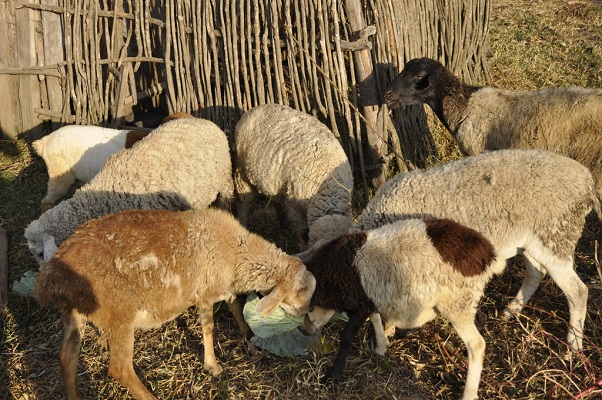

Sheep are a prey species, and their only defense is to flee. Sheep display an intensely gregarious social instinct that allows them to bond closely to other sheep and preferentially to related flock members. Flock mentality movements protect individuals from predators. Flocks include multiple females, offspring, and one or more males. Ewes tend to stay in their maternal groups for life, whereas rams may form transient, unstable, and easily disbanded bachelor herds. If most rams in a group die because of fights or diseases, those remaining join another group. Under standard grazing situations, sheep graze together in casual affiliations; social hierarchies are not as apparent as they are for cattle.
Flock dynamics are apparent in groups of four or more as evidenced by willingness to follow a leader or flee in unison. When escape is prevented, even a ewe may charge or threaten by hoof stomping. Separation from the flock can cause stress and panic. Isolation from other sheep can cause severe stress and should be avoided. Mirrors can be used in the absence of other sheep.
Males in rut will physically challenge one another for social rank and breeding privileges. Social rank depends on the presence and size of horns, body mass, and height at the withers and hocks. Age may also play a role, because the mortality of lambs from yearling ewes is extremely high. Higher-ranking males concentrate on courting females when in rut and do not graze to the extent lower-ranking rams do. Groups of 40–50 ewes/adult ram and 25–30 ewes/juvenile ram are common management choices. Mortality in rams is five times that in ewes. Generally, subordinates and lower-ranking rams are excluded from breeding, unless lower-ranking animals outnumber the higher-ranking male and serve to distract or otherwise occupy him (this need not be cooperative). While the higher-ranking male usually has larger horns, the role of the demographic environment (ie, the number of lower-ranking males in the group) prevents an extreme selection response for these secondary sex characteristics.
In large groups of sheep or in sheep on large pastures, more subordinates are likely to mate. In tightly confined, relatively small groups, the role the social order plays in mating is critical, and owners should understand that lower-ranking rams may not mate under such conditions.
Sheep are seasonally polyestrous and reach puberty at 7–12 months. Mating behavior includes nudging, kicking, or pawing with the front legs, low stretching, and pushing. These same behaviors and head-to-head banging with horn clashing occur in conflicts between males.
Artificial weaning occurs at 10 wk of age, but these lambs recognize and will return to the ewes after a 2-mo separation. Sheep are naturally weaned at 6 mo of age, usually when their mother again comes into heat. Ewe lambs continue to follow the dam, but ram lambs do not.
Sheep are likely to be more intelligent than generally regarded. They respond readily to food calls, may problem solve, learn their names, carry packs, and can even be clicker trained. Sheep may be grazed on open, unfenced areas and may heft (remain in home field) to a limited area as a learned behavior by lambs from their ewes. Sheep possess specialized neural mechanisms in the right temporal and frontal lobes of the brain and may recognize familiar human or ovine faces for as long as 2 yr.
 Contact Jaguza Support
Contact Jaguza Support